
Whitehorse is the capital of the Yukon, and the largest city in Northern Canada. It was incorporated in 1950 and is located at kilometre 1426 on the Alaska Highway in southern Yukon. Whitehorse's downtown and Riverdale areas occupy both shores of the Yukon River, which rises in British Columbia and meets the Bering Sea in Alaska. The city was named after the White Horse Rapids for their resemblance to the mane of a white horse, near Miles Canyon, before the river was dammed.

Yukon is the smallest and westernmost of Canada's three territories. It is the most densely populated of the three territories, with an estimated population of 46,948 as of 2024, though it has a smaller population than all provinces. Whitehorse, the territorial capital, is the largest settlement in any of the three territories.

Dawson City, officially the City of Dawson, is a town in the Canadian territory of Yukon. It is inseparably linked to the Klondike Gold Rush (1896–1899). Its population was 1,577 as of the 2021 census, making it the second-largest municipality in Yukon.
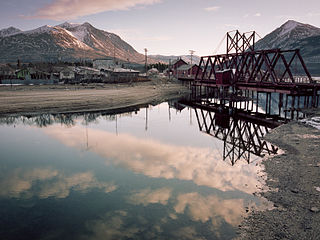
Carcross, originally known as Caribou Crossing, is an unincorporated community in Yukon, Canada, on Bennett Lake and Nares Lake. It is home to the Carcross/Tagish First Nation.
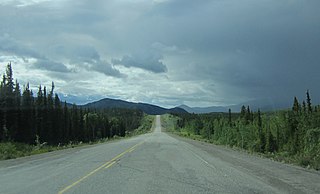
Ibex Valley is a hamlet in Canada's Yukon. The hamlet is considered a local advisory area with an advisory council providing local government. Its population, according to the 2021 Canadian Census, was 523.
Marsh Lake is a widening of the Yukon River southeast of Whitehorse, Yukon, Canada. It is over 30 kilometres (19 mi) long and ranges from three to four kilometres wide. It has an area of 96.3 km2 (37.2 sq mi) and a mean depth of 12.8 m (42 ft). The co-ordinates of the lake are 60°26′10″N134°15′02″W, and is 654 metres (2,147 ft) above sea level. The lake forms part of a chain of finger lakes, sometimes referred to as "The Southern Lakes", that form the headwaters of the Yukon River.
Canyon City is a Klondike Gold Rush ghost town and a Yukon Government Heritage Site. It is located about 7 km from downtown Whitehorse, Yukon, at the upstream end of Miles Canyon on the Yukon River. Summer tours are encouraged.
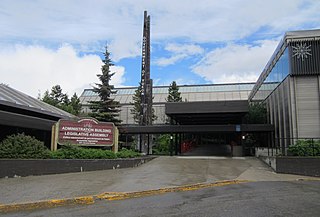
The Yukon Legislative Building is home to the Yukon Legislative Assembly. Located in Whitehorse, Yukon, the building is a three-storey white steel-clad structure. The complex is located next to the Yukon River and Rotary Park.

Whitehorse West is an electoral district which returns a member to the Legislative Assembly of the Yukon Territory in Canada.
Yukon Brewing is a trademark owned by the Chilkoot Brewing Co. Ltd brewery in Whitehorse, Yukon, Canada.

CIAY-FM, branded as Life 100.7, is a Christian radio station in Whitehorse, Yukon, Canada. CIAY-FM broadcasts at 100.7 FM airing a combination of religious programming and Contemporary Christian music.
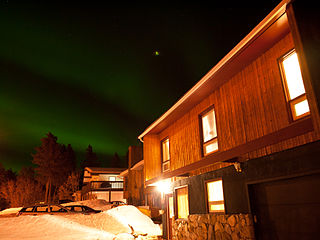
Riverdale is a neighbourhood within the city of Whitehorse, Yukon, Canada. The community is separated from Whitehorse City Centre by the Yukon River, and is linked to Whitehorse via Lewes Boulevard, a major thoroughfare in the community.
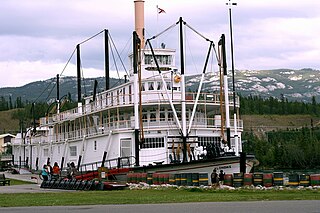
SS Klondike is the name of two sternwheelers, the second now a National Historic Site located in Whitehorse, Yukon. They ran freight between Whitehorse and Dawson City, along the Yukon River, the first from 1929 to 1936 and the second, an almost exact replica of the first, from 1937 to 1950.
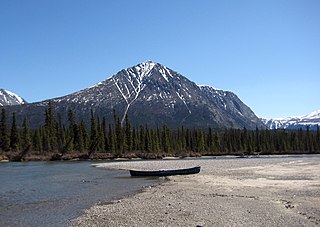
The Takhini River is a watercourse in Yukon, Canada. The river is located just north of Whitehorse, Yukon, and flows from west to east, meeting the Yukon River at a point between Whitehorse and Lake Laberge. During the winter, the river freezes and serves as part of the route of the Yukon Quest sled dog race.

The Whitehorse Waterfront Trolley is a heritage streetcar service in Whitehorse, Yukon, Canada.
Frederick Howard Collins October 1, 1897 – August 24, 1988) was the commissioner of Yukon from 1955 to 1962. He succeeded Wilfred George Brown and was followed in the position by George Robertson Cameron. The Yukon territorial government today resembles those in the Canadian provinces, i.e., parliamentary with a Legislative Assembly and a Premier as head of government. But historically, and during the term of Collins, the federally-appointed Commissioner was the empowered chief executive of the territory.

The MacBride Copperbelt Mining Museum formally the Copperbelt Railway & Mining Museum (CR&MM) is run by the Miles Canyon Historic Railway Society (MCHRS), which consists of a board of six members. The objectives of the society are to: a) To preserve, promote and to protect the railway heritage of the Yukon; b) To develop and operate the Waterfront Trolley; c) To develop and operate the Copperbelt Railway & Mining Museum; and d) To promote and enhance tourism development in the city of Whitehorse and the Yukon.

Downtown Whitehorse is a neighbourhood in Whitehorse, Yukon, Canada. The downtown area serves as Whitehorse's city centre and central business district.

The Kwanlin Dün Cultural Centre is a cultural centre of the Kwanlin Dün First Nation located in Whitehorse, Yukon, Canada. The centre opened in June 2012. The centre consists of a long house, artists studios, a gallery, classrooms, and an outdoor ceremonial space on the banks of the Yukon River. Attached to the Kwanlin Dün Cultural Centre, but separate, is the Whitehorse Public Library. The centre hosts the Adäka Cultural Festival and the Shakaat Artist Residency during summer months.

The Yukon Transportation Museum (YTM) is a non-profit organization and registered charity located in Whitehorse, Yukon, Canada, on the traditional territories of the Ta'an Kwächan Council and the Kwanlin Dün First Nation. Founded in 1990, YTM specializes in exhibiting and examining the Yukon Territory's rugged character through stories of ingenious and self-sufficient transportation modes, entrepreneurs, pioneers and inventors. The museum's mandate is to 'identify, acquire, preserve and conserve the history, cultural material and artifacts of Yukon's transportation modes, and to interpret this history in an educational manner for all Yukoners and visitors alike.'
















